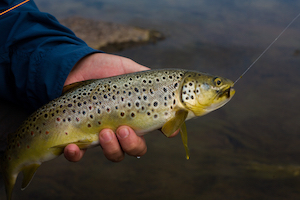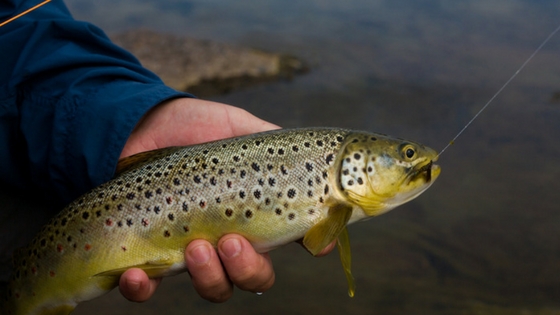Brown Trout An Introduction

 Brown Trout’s name, Salmo trutta means both salmon and trout
Brown Trout’s name, Salmo trutta means both salmon and trout
Is the German Brown Trout the same species?
Brown trout is known by many names in different parts of the world. Common names include the German brown, German trout, German brown trout, Loch Leven trout, European brown trout, English trout, von Behr trout, brownie, sea trout, lake trout, brook trout and river trout.
Feeding Habits
Like other members of the trout species, the Brown Trout are cannibals. They’ll eat their own young.
Even so, Brown Trout are one of the trout species most likely to strike an artificial fly, which helped them become the top game fish in Europe. Most of the European fishing waterways are in the form of rivers and streams.
It’s for this reason that the Brown Trout has remained an all-time favorite of dedicated fly fishermen since the fifteenth century.
This hardy fish can tolerate water temperatures from 5 degrees to more than 10 degrees warmer than can other trout species. They also inhabit semi-polluted waters and rivers with lower-than-average oxygen levels.
Unlike other trout species the Brown Trout can be found living in rivers, streams, landlocked lakes and are also ocean going.
Highly Territorial
Brown trout are highly territorial. Even when they’re not hungry, they can be tempted to strike at a lure by appealing to their sense of territory and their need to defend it.
When fishing for Brown Trout, think about open stretches of water as potential fishing opportunities.
Brown Trout, more than any other species, will strike baits that are in its territory. And this territory can stretch a considerable distance.
Brown Trout Distribution
The Brown Trout wasn’t widely available in central North America until the 1800s when they were introduced to many lakes and rivers in New England.
Many anglers in the United States and Canada make the summation that the Brown Trout is native to North America and can only be found here. However the Brown Trout is native to Europe and Asia and is actually considered to be circumpolar.
This species also has landlocked populations far from the oceans on many continents and countries like Greece, Estonia, the United States, Canada, New Zealand and Venezuela.
Originally from Europe and North Africa, the brown trout was introduced to North America in 1882.
Of the thousands of eggs imported to Massachusetts, the 3 surviving fish were the source of today’s North American brown trout fishery.
The Brown Trout is a top species for fisheries the world over.
In North America the brown trout is found in rivers and lakes, with the exception of the most southerly American states. This is due to the high temperatures of the water during the summer months, which exceeds their maximum temperature range. They’ve been introduced to Texas but with very limited success.
Limited to the northern end of their distribution, they’re not found in northern Canada or Alaska.
The Brown Trout’s name, Salmo trutta means both salmon and trout. The Brown Trout was the first species of trout identified by Carl Linnaeus in the book “The System of Nature” in 1758.
Linnaeus is better known as the person who gave rise to the modern ethos of classification of animals and plants, known as taxonomy.


